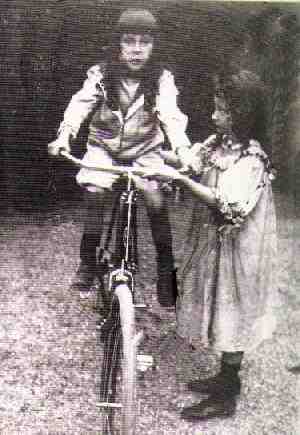
Figure 1.--.


Figure 1.--. |
The post World War boom of the 1920s created properity in America. Wages grew. Many families purchased automobiles. The prices of bikes fell. Bikes became within the reach of a wide range of American kids. Another key factor was the improvements which made them safe enough for children to use. Parents began purchasing bikes for their children in large numbers.

Figure 2.--Jacques, the son of Emile Zola, is being helped by his sister to ride his bike in this turn of the century photograph. Notice his long hair and above the knee knickers. |
Manufacturers desperate to find new customers as adults turned to automobiles, increasingly turned to children. Manufacturers, such as Mead, Sears
Roebuck, and Montgomery Ward after the First World War introduced several new models to revitalize the bike industry. Schwinn made its big splash slightly later. The popularity of bicycles increased in America in the years before World War II. All Anerican boys considered getting their first two-wheel Swinn a virtual rite of passage.
The post-World war I designs, now called "classics", featured automobile and motorcyle elements to appeal to kids who, presumably, would rather have a motor. If ever a bike needed a motor, this was it. These bikes evolved into the most glamorous, fabulous, ostentatious, heavy designs ever. It is unbelievable today that 14-year-old kids could do the tricks that we did on these 65
pound machines! They were built into the middle 50s, by which time they had taken on design elements of jet aircraft and even rockets. By the 60s, they were becoming leaner and simpler.
Navigate the Boys' Historical Clothing Web Site:
[Return to the Main bike page]
[Introduction]
[Chronology]
[Clothing styles]
[Biographies]
[Bibliographies]
[Contributions]
[Boys' Clothing Home]
Navigate the Boys' Historical Clothing Web Site:
[Sailor suits]
[Sailor hats]
[Buster Brown suits]
[Eton suits]
[Rompers]
[Tunics]
[Smocks]
[Pinafores]
